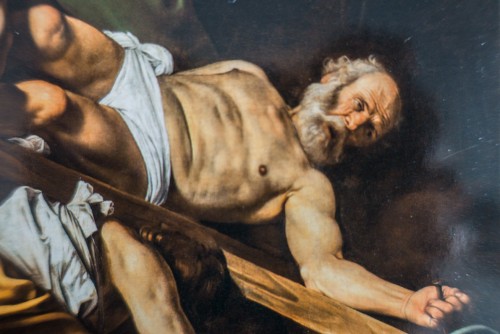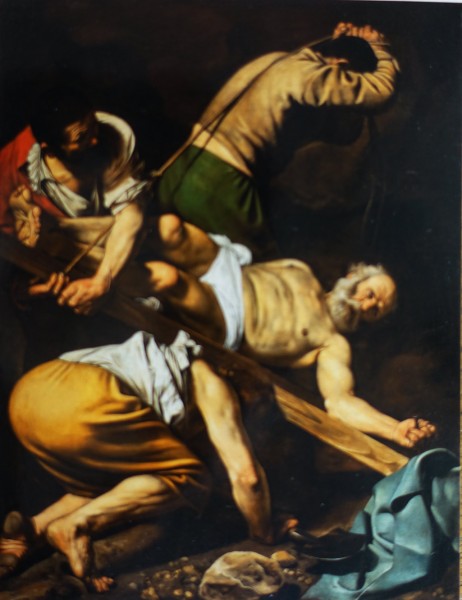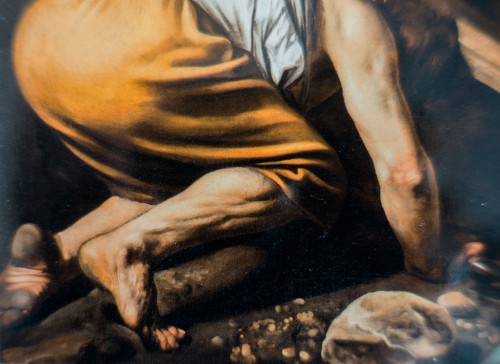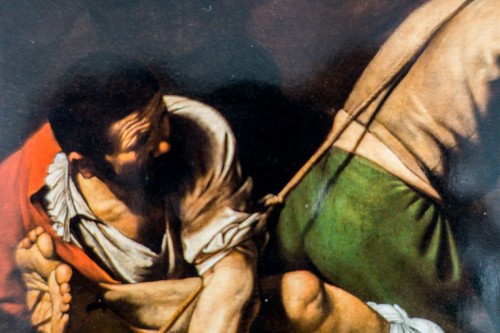Caravaggio’s The Crucifixion of St. Peter – a painting on the banality of evil

The Crucifixion of St. Peter, fragment, Caravaggio, Cerasi Chapel, Basilica of Santa Maria del Popolo

The Crucifixion of St. Peter, Cerasi Chapel, Basilica of Santa Maria del Popolo

The Crucifixion of St. Peter, fragment, Caravaggio, Cerasi Chapel, Basilica of Santa Maria del Popolo

Caravaggio, The Crucifixion of St. Peter, fragment, Cerasi Chapel, Basilica of Santa Maria del Popolo
Peter – a humble fisherman from Bethsaida will soon be raised along with the cross to which he has been nailed. He looks on as if in disbelief upon one of the nails, with which his hand has been affixed to the cross. In a short while, the martyrdom of the most important of apostles shall begin, the one whom Christ called the Rock ("upon this Rock, I shall build my Church"). We can see this very rock in a scaled-down form – it is the stone in the foreground. However, it is not this stone that draws our attention, but rather the lonely, helpless man, who is far removed from the image of a saint, although he is the most important among them.
Peter – a humble fisherman from Bethsaida will soon be raised along with the cross to which he has been nailed. He looks on as if in disbelief upon one of the nails, with which his hand has been affixed to the cross. In a short while, the martyrdom of the most important of apostles shall begin, the one whom Christ called the Rock ("upon this Rock, I shall build my Church"). We can see this very rock in a scaled-down form – it is the stone in the foreground. However, it is not this stone that draws our attention, but rather the lonely, helpless man, who is far removed from the image of a saint, although he is the most important among them.
We can have no doubts, that in this work – found in the Cerasi Chapel in the Basilica of Santa Maria del Popolo, similarly to the previously painted Conversion of St. Paul, Caravaggio patterned himself on the scene from the Pauline Chapel, created fifty years prior by the great Michelangelo. And while in the latter’s version the oppressors take the form of Roman soldiers, in Caravaggio’s version these are unnamed workers, with faces covered by shadows, who strain to finish the work with which they have been entrusted. Does their lack of attention towards the torture in front of their very eyes and the diligence with which they perform their task, perhaps hurrying to start another, not show the deep reflection of the artist upon the human condition? Here is a throng of anonymous, guilt-free oppressors – silent, carrying out orders – and the lonely, bereft of any audience victim.

We do not know, whether Caravaggio, as it had been written in the contract concluded between him and his client (Tiberio Cerasi), painted the previous painting on wood and it had been rejected, as was the case with The Conversion of St. Paul. It is, however, certain, that the painting which we now look upon was a gauntlet thrown in front the then audience but especially to the executors (the friars from the Church of Santa Maria della Consolazione) of the will of the client, who had died during the works. The painter, as was his habit, did not complete an initial sketch, he painted directly on canvas. He selected the models for his scene from among the simple folk, people he had met on the street. Thanks to this, his Crucifixion is a simple painting.
As we know Peter had wished to be crucified upside down, in opposition to the way Christ had died since the disciple did not feel worthy to perish in the same way as his Teacher had perished. Yet, now he seems surprised by the whole situation. Where is the Rock – the foundation of the Church? – we could ask. It is not noticed by his oppressors – simpletons who carry out the execution for a pittance, firmly believing that it is a job like any other. They are the ones whom the painter focuses on, their effort and skill.
The scene is without any context, without any witnesses and it is furthermore submerged in merciless darkness. In the world of Caravaggio, there is no place for heroes and saints – it is prosaic, cruel, but also very real.
The Crucifixion of St. Peter, Caravaggio, 1601, oil on canvas, 230 cm x 175 cm, Cerasi Chapel, Basilica of Santa Maria del Popolo
If you liked this article, you can help us continue to work by supporting the roma-nonpertutti portal concrete — by sharing newsletters and donating even small amounts. They will help us in our further work.
You can make one-time deposits to your account:
Barbara Kokoska
BIGBPLPW 62 1160 2202 0000 0002 3744 2108
or support on a regular basis with Patonite.pl (lower left corner)
Know that we appreciate it very much and thank You !










